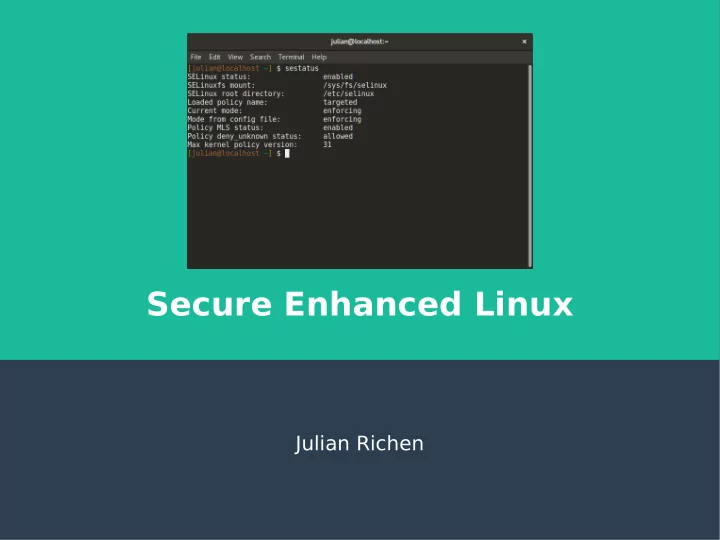

Secure Enhanced Linux Julian Richen
SELinux? ● Started as a research project from the National Security Agency (NSA) ● A set of patches using the Linux Security Modules (LSM) – Hardening GNU/Linux systems with extra security policies and enforcing Mandatory Access Control (MAC) – Similar to modules like AppArmor, Smack, TOMOYO ● NSA published the code under the GPL in 2000 ● Upstream Linux kernel adopted patches in 2003 2
Who develops it? ● NSA ● Red Hat ● MITRE Corporation ● Secure Computing Corporation (SSC) ● Individual contributors & companies – CUPS Project, SAMBA Project, IBM, Tresys T echnology, and more ● Full list: – https://www.nsa.gov/what-we- do/research/selinux/contributors.shtml 3
Source? ● Source: – https://github.com/SELinuxProject/selinux ● Bugs – NSA: selinux@tycho.nsa.gov – Red Hat: https://bugzilla.redhat.com/ ● Policies – https://github.com/T resysT echnology/refpolicy 4
Who uses it? ● Linux Distros – RHEL, Fedora, SuSE, CentOS, Debian, Ubuntu ● United States Government – NSA, DoD, etc… ● Enterprise – Data sensitive companies, healthcare, or anyone really ● Android – Google implemented SELinux in Android 4.3 (2015) 5
What does it solve? ● Implements Mandatory Access Control (MAC) – Focus on process context instead of role-based security (think DAC) – Enhances Discretionary Access Control (DAC); aka Ownership (user, group, other) with read/write/exec permissions ● MAC policies can be set for: – Users – Files – Directories – Memory – Sockets – tcp/udp ports – And more! 6
Discretionary Access Controls ● Access to objects is restricted based on the identity of a subject and/or group (ownership + permissions). ● Controls are “discretionary” because subjects have a level of permissions that allow them to reach a subject. 7
Discretionary Access Controls Group Other User r w x r w x r w x 8
Mandatory Access Control ● Operating Systems constrain the ability of the subject to access or perform operation on an object or target. ● Basically, access to objects is restricted based on the security levels set by the security context. 9
How does SELinux work? ● It’s basically Mandatory Access Control – SELinux doesn’t replace DAC, MAC can work alongside DAC – SELinux can be enabled/disabled at anytime and system will fallback to DAC ● SELinux uses “Labels” for MAC – These labels are then followed with “T ype Enforcement” – SELinux needs extended attributes on fjle-system to work ● Labels are added as extended attributes ● Use or make security policies – Security policies are just pre-made lists of labels for lots of packages on a GNU/Linux system – SELinux ships with targeted, minimum and mls as defaults. 10
Labeling & Type Enforcement ● Labeling – Every object (fjle, process, port, etc..) has a SELinux context/label ● Label’s job is to create logical groups/levels which the object may interact with – Format ● user:role:type:level(optional) – Labels should be logical, e.g a http servers & ports 80/443 should be grouped together because a http will use those ports ● Type Enforcement – The part of the policy that says a subject with “abc label” can interact with an object with “xyz label”. 11
Label & Type Enforcement Example ● It makes sense that httpd_* labeled label Object objects should interact together. httpd process httpd ● It doesn’t make sense for httpd /usr/bin/httpd httpd_exec_t labeled content to access sensitive /etc/httpd/ httpd_config_t fjles like /etc/shadow or fjles in the home directory. /var/log/httpd/ httpd_log_t /var/www/html/ httpd_sys_content_t Port 80 & 443 httpd_port_t /etc/shadow shadow_t /home/<user>/* user_home_t 12
SELinux Policies ● Policy – Enforcing ● Enforce all policies. – Permissive ● Prints warnings instead of enforcing. – Disabled ● No policy is loaded. ● Types – Targeted ● Support a greater number of confjned daemons, can confjne other users and areas. Good confjnement for most use-cases. – Minimum ● Support minimal set of confjned daemons, rest are set as unconfjned. Used for users to test SELinux and devices that only need to confjne a few daemons. – MLS ● Multi Level Security protection, lots of confjned daemons and users. Used in high-security environments (think Government). – Write your own ● You can write policies that fjt your machine, business, etc… 13
cat /etc/selinux/confjg 14
Attributions ● Docs on SELinux source – https://github.com/SELinuxProject/selinux ● Red Hat’s Thomas Cameron yearly SELinux presentation: – http://people.redhat.com/tcameron/Summit2017/SElinux/selinux_f or_mere_mortals_2017.pdf ● Fedora docs – https://docs-old.fedoraproject.org/en- US/Fedora/25/html/SELinux_Users_and_Administrators_Guide/inde x.html ● SELinux intro by Digital Ocean – https://www.digitalocean.com/community/tutorials/an- introduction-to-selinux-on-centos-7-part-1-basic-concepts 15
Recommend
More recommend